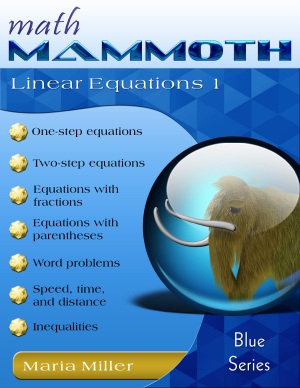Math Mammoth Linear Equations 1

123 pages
(includes answers)
Sample pages (PDF)
Contents
Two-Step Equations, Part 1
Word Problems and Equations, Part 1
Equations with Fractions 1
Inequalities
Prices & ordering
PDF download USD $7.50
You will be purchasing the downloads from my authorized reseller Comecero.
Printed copy $12.35
 Este libro en español
Este libro en español
Math Mammoth Linear Equations 1 focuses on the linear equations of the types px + q = r and p(x + q) = r and best suits 7th grade mathematics studies. The book assumes that the student has already learned to solve simple one-step equations (for example −6x = 24 or x + 9 = −2). The equations in this book go one step further from that, into equations that typically require two steps (occasionally more) to solve and may contain parentheses.
The next step after this book (in 8th grade or in an algebra 1 course) is to learn to solve complex, multi-step linear equations — yet the beauty of mathematics is that even those complex equations will be able to be reduced to these simpler forms covered in this book.
The book contains several lessons where we focus writing an equation for a word problem. Students solve these word problems both using arithmetic and using an equation, comparing the solution steps.
There is also a lesson on patterns of growth, which may seem to be simply a fascinating topic, but in reality presents the fundamentals of a very important concept in algebra―that of linear functions (although they are not mentioned by that name).
After the section about equations, the text presents the basics of inequalities and how to graph them on a number line. Students apply the principles for solving equations to solve simple inequalities and word problems that involve inequalities.
The equations in this book are limited in complexity, with the variable on one side only, and usually only requiring two (sometimes three) steps to solve. In 8th grade, or in an algebra course, students solve multi-step linear equations, including those with the variable on both sides of the equation, thus completing their understanding of how to solve linear equations.
You will find free videos covering many topics of this book at
https://www.mathmammoth.com/videos/ (choose 7th grade).
Good Mathematical Practices
- Many of the word problems ask students to compare an algebraic solution to a word problem with an arithmetic solution. This allows them to see the differences and similarities in the two approaches, and to wisely choose later on which approach or “tool” is more efficient.
- Encourage students to check each solution to an equation that they find. Checking and reflecting on your own work is an important habit, and is especially important in mathematics, where we often seek a precise answer to a question.
- Choosing a variable for the unknown in a word problem and writing an equation for the situation (in other words, representing a situation abstractly and symbolically) is an important skill practiced in this book. It is, in fact, an important subskill when modeling with mathematics.
The PDF version of this book can be filled in on a computer, phone, or tablet, using the annotation tools found in many PDF apps. See more.
A sequel to this book, Math Mammoth Linear Equations 2 delves into more complex linear equations, and into how many solutions a linear equation can have.
Better Yet - Bundle Deals!
Blue Series - $165 (download)Blue Series for grades 1-3 - $49 (download)
Blue Series for grades 4-5 - $47 (download)
Blue Series for grades 6-8 - $69 (download)
Light Blue Series, grades 1-8 - $225 (download)
Light Blue Series, grades 1-4 - $112.50 (download)
Light Blue Series, grades 5-8 - $112.50 (download)
All Inclusive Bundle - $275 (download)
"Everything" Bundle - $330 (download)
Learn more about the bundles!
*BONUS*: Buy any bundle listed above, and get the fully upgraded Soft-Pak software for FREE (includes 4 math and 2 language arts programs, complete with on screen and printable options).
How and where to order
You can buy Math Mammoth books at:
- Here at MathMammoth.com website — simply use the "Add to cart" buttons you see on the product pages.
- Rainbow Resource carries printed copies for the Light Blue series books, plus several CDs (Light Blue and Blue series).
- Homeschool Buyers Club offers download versions of the Light Blue series, plus the Blue series bundle.
- Homeschool Planet sells the digital versions of the main curriculum and lesson plans to go with them.
- K5 Learning offers download versions of the Blue series.
- TPT sells the Light Blue Series downloads, plus topical units.
- Lulu sells printed copies for most of the Math Mammoth materials (various series).
By purchasing any of the books, permission IS granted for the teacher (or parent) to reproduce this material to be used with his/her students in a teaching situation; not for commercial resale. However, you are not permitted to share the material with another teacher.
In other words, you are permitted to make copies for the students/children you are teaching, but not for other teachers' usage.
Math Mammoth books are PDF files. I recommend you use Adobe Reader to view them, including if you use a Mac. You can try other PDF viewers, but they may at times either omit or mess up some of the images.
Receive my monthly collection of math tips & resources directly in your inbox — and get a FREE Math Mammoth book!
You can unsubscribe at any time.
Math Mammoth TourConfused about the different options? Take a virtual email tour around Math Mammoth! You'll receive: An initial email to download your GIFT of over 400 free worksheets and sample pages from my books. Six other "TOURSTOP" emails that explain the important things and commonly asked questions concerning Math Mammoth curriculum. (Find out the differences between all these different-colored series!)This way, you'll have time to digest the information over one or two weeks, plus an opportunity to ask me personally about the curriculum. A monthly collection of math teaching tips & Math Mammoth updates (unsubscribe any time) We respect your email privacy.
Note: You will FIRST get an email that asks you to confirm your email address. If you cannot find this confirmation email, please check your SPAM/JUNK folder. |
"Mini" Math Teaching CourseThis is a little "virtual" 2-week course, where you will receive emails on important topics on teaching math, including:
- How to help a student who is behind You will also receive: A GIFT of over 400 free worksheets and sample pages from my books right in the very beginning.We respect your email privacy.
Note: You will FIRST get an email that asks you to confirm your email address. If you cannot find this confirmation email, please check your SPAM/JUNK folder. |
Maria's Math TipsEnter your email to receive math teaching tips, resources, Math Mammoth news & sales, humor, and more! I tend to send out these tips about once monthly, near the beginning of the month, but occasionally you may hear from me twice per month (and sometimes less often). Peek at the previous tips here. You will also receive:
We respect your email privacy.
|
|
